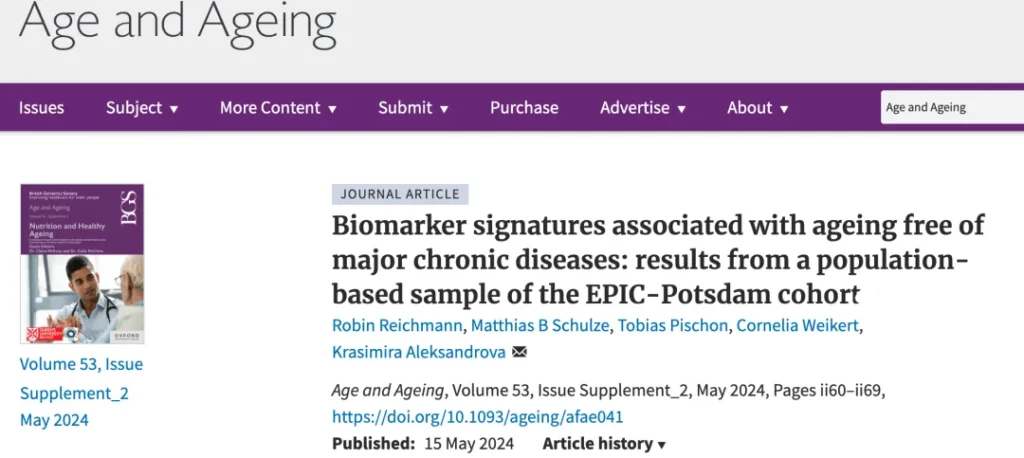As we grow older, many people wish for one thing above all: longevity. But is living a long life really the greatest joy? The truth is, longevity alone may not be the key to happiness. Imagine living a long life but battling illness every day — would that be a true blessing or a burden? The real goal is not just to live a long life, but to live a healthy life.
So, how can we achieve both longevity and good health? Recent research has uncovered four key physiological indicators that play a crucial role in helping us live longer and healthier lives, minimizing the risk of chronic illnesses. Here’s a closer look at these essential indicators.
4 Key Indicators for a Longer, Healthier Life
In May 2024, a study published in the journal Aging and Geriatrics in Germany identified four physiological factors that are closely linked to longevity. By managing these indicators, you can not only live longer but enjoy fewer diseases as you age.

Research screenshots
The research, conducted on 2,500 participants ranging from 20 to 67 years old, found that focusing on four biomarkers can significantly improve your chances of living a long and healthy life. These four biomarkers include:
- High-Density Lipoprotein Cholesterol (HDL-C): Often referred to as “good cholesterol,” HDL-C helps transport excess cholesterol to the liver for elimination. High levels of HDL-C are associated with a reduced risk of heart disease and atherosclerosis.
- Adiponectin: This protein, secreted by fat cells, plays a crucial role in improving insulin sensitivity, regulating fat metabolism, and reducing inflammation. It’s often referred to as the body’s “early diabetes scout” due to its role in preventing metabolic diseases.
- Insulin-like Growth Factor Binding Protein 2 (IGFBP-2): IGFBP-2 binds to insulin-like growth factors, enhancing metabolism and helping to prevent atherosclerosis. It’s a key player in protecting against neurodegenerative diseases.
- Triglycerides: The level of triglycerides in your blood provides important insights into your health. High or low triglycerides can be a sign of metabolic problems, including dyslipidemia. Elevated triglycerides often signal poor lipid metabolism.

Lifestyle Tips to Manage These Key Indicators
Now that we know which physiological indicators are essential, the next question is: how do we control them? Here are five lifestyle habits that can help you effectively manage these markers:
1. Eat a Balanced Diet
What you eat significantly impacts your health and longevity. A diet high in fats, sugar, and salt not only contributes to obesity but also raises the risk of cancer and chronic diseases. Aim for a diet rich in vegetables, fruits, whole grains, lean proteins, and healthy fats.
- Increase whole grains and cut back on refined carbs like white rice.
- Use plant oils and cook at low temperatures.
- Favor white meats (like fish and chicken) over red meats (beef, lamb).
- Opt for steaming, boiling, or poaching instead of frying.
A well-rounded diet ensures that your body gets the nutrients it needs while preventing diseases that could shorten your life.

2. Exercise Regularly
“Movement is life.” Regular physical activity not only extends lifespan but also enhances metabolism and helps prevent diseases like cancer and cardiovascular issues. Moderate-intensity activities, like brisk walking, swimming, and cycling, are ideal for promoting longevity.
During moderate exercise, aim for a heart rate between 100-140 beats per minute. You should feel slightly breathless but not exhausted.

3. Maintain a Healthy Weight
Being overweight can increase triglyceride levels and is a key factor in various chronic diseases. Maintaining a healthy weight helps prevent diseases like Alzheimer’s and heart disease. You can manage your weight by:
- Checking your weight weekly to detect early fluctuations.
- Avoiding eating after 5 PM to fight aging and promote better metabolism.
Maintaining a healthy weight can be one of the most effective strategies for living longer and more healthily.

4. Quit Smoking
Smoking accelerates aging and contributes to a wide range of diseases, including cancer and heart disease. Quitting smoking, especially before the age of 35, can significantly reduce the risks of smoking-related mortality. Studies confirm that quitting early can reverse the harmful effects of smoking.

5. Manage Stress and Emotions
A positive mindset and stress management are essential for longevity. Chronic stress leads to inflammation, which can contribute to cardiovascular disease, obesity, and digestive problems. Spending time in nature can help reduce stress and prevent anxiety. Studies show that a walk in a park or green space can significantly lower stress levels.

Conclusion: Health is the Key to Longevity
Living a long and healthy life is about more than just avoiding illness — it’s about adopting habits that promote well-being in every aspect of life. By focusing on a balanced diet, regular exercise, healthy weight maintenance, smoking cessation, and stress management, you can improve your chances of living a long life free of chronic diseases. Remember, health is the true essence of longevity!



















